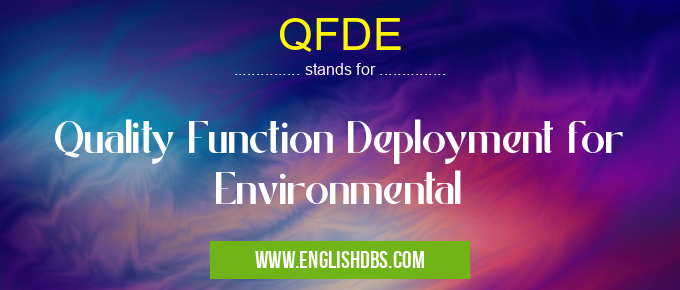What does QFDE mean in ENVIRONMENTAL
In the governmental context, QFDE is used to ensure that environmental regulations and standards are considered and met during the development of policies, programs, and projects. It helps government agencies identify and address the potential environmental impacts of their actions, promoting sustainable decision-making.

QFDE meaning in Environmental in Governmental
QFDE mostly used in an acronym Environmental in Category Governmental that means Quality Function Deployment for Environmental
Shorthand: QFDE,
Full Form: Quality Function Deployment for Environmental
For more information of "Quality Function Deployment for Environmental", see the section below.
QFDE Meaning in GOVERNMENTAL
QFDE Full Form
- Quality
- Function
- Deployment
- for
- Environmental
What does QFDE Stand for
QFDE is a structured process that involves:
- Identifying customer requirements and environmental concerns
- Creating a matrix that links customer requirements to environmental impacts
- Developing strategies to address environmental concerns
- Implementing and monitoring environmental improvements
Essential Questions and Answers on Quality Function Deployment for Environmental in "GOVERNMENTAL»ENVIRONMENTAL"
What is Quality Function Deployment for Environmental (QFDE)?
QFDE is a structured approach that translates customer environmental requirements into design targets and specifications. It enables organizations to develop products and services that meet or exceed customer expectations for environmental performance.
How does QFDE differ from traditional QFD?
Traditional QFD focuses on customer quality requirements, while QFDE specifically addresses environmental requirements. It incorporates additional factors such as resource consumption, emissions, and environmental impact into the product development process.
What are the benefits of using QFDE?
QFDE offers numerous benefits, including:
- Improved compliance with environmental regulations
- Reduced environmental impact of products and services
- Increased customer satisfaction and loyalty
- Enhanced brand reputation and competitive advantage
How is QFDE implemented in practice?
QFDE follows a structured process, typically involving:
- Defining customer environmental requirements
- Creating a House of Quality (HOQ) to map requirements to design targets
- Developing design specifications to meet environmental targets
- Implementing environmental improvements throughout the product development lifecycle
What are the challenges associated with QFDE?
QFDE can be challenging due to:
- Lack of clear environmental requirements from customers
- Difficulty quantifying environmental impacts
- Balancing environmental performance with other design considerations
How can organizations overcome these challenges?
To overcome these challenges, organizations should:
- Engage with customers to gather specific environmental requirements
- Use life cycle assessment (LCA) to quantify environmental impacts
- Prioritize environmental performance while considering other design factors
- Collaborate with suppliers and other stakeholders to ensure alignment on environmental goals
Final Words: QFDE is a valuable tool for organizations and governments seeking to minimize their environmental footprint and promote sustainability. By integrating environmental considerations into the design process, QFDE helps reduce the risk of environmental damage, enhance product and process quality, and build trust with stakeholders.
